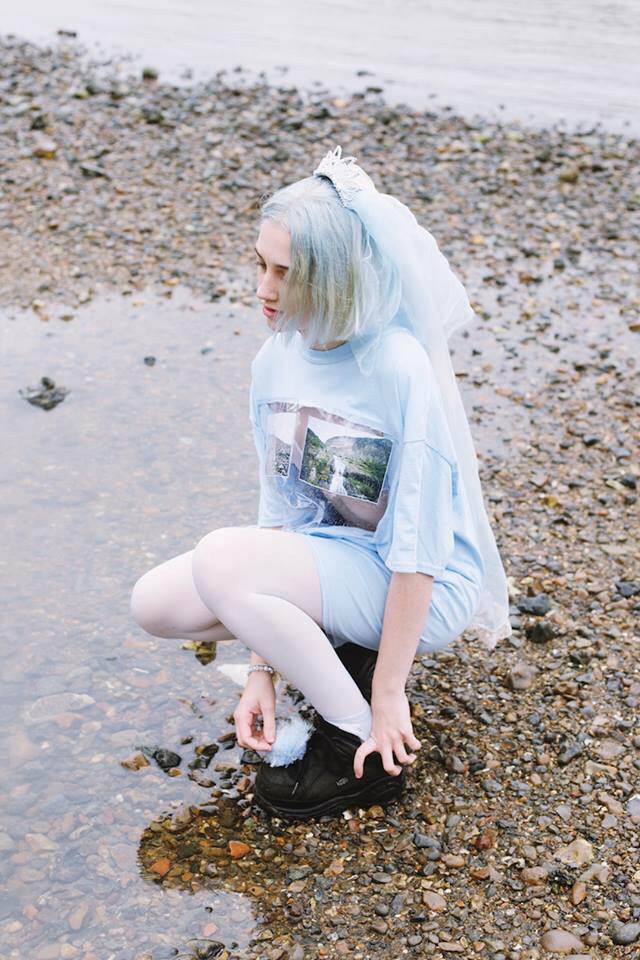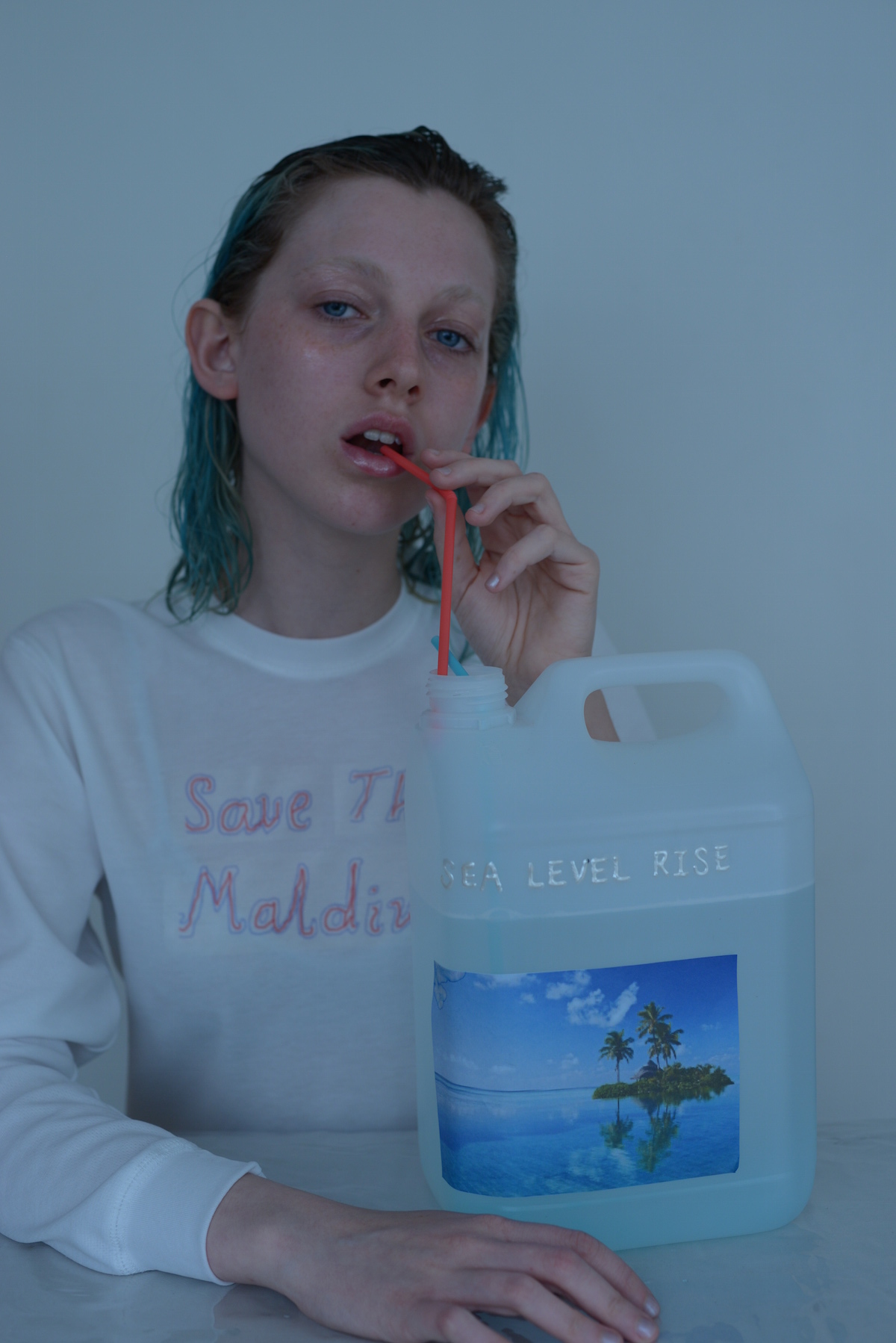Climate change is an issue that’s so big it can be hard to comprehend, let alone connect with. We all want to do our bit and it helps if there’s a person who can speak to us about it on our level. Someone who can reasonably explain why Arctic sea ice declining at a rate of 13.3% per decade is serious. Someone who can illustrate in an interesting way why the global average sea level rising nearly seven inches over the last 100 years is dangerous. Someone who can show why the global temperature rising 1.4ºF puts all of our lives at risk.
Luckily for us, Elizabeth Farrell has volunteered to be that person. The 19-year-old invented the superhero pseudonym Glacier Girl and her project, Remember The Glaciers, as a way to speak to her peers about the dangers of global warming.
What began as a high school art assignment has become a calling for Elizabeth, who was awarded a Gap Year Scholarship by Britain’s Royal Geographical Society last year to focus on the project full-time. She devoted herself to DIY activism, making clothes and staging photo shoots for her growing community on Instagram, Twitter and Tumblr.
Among them is New Zealand photographer Connie McDonald, who became a part of the project after reaching out to Elizabeth for a shoot when she was in England. The pair have collaborated many times since and even traveled to Iceland to take in the glaciers together.

With her seafoam-blue hair and subversive fashion sense, Elizabeth appeals to those of us who potentially have trouble relating to more traditional environmental activists. By adapting the familiar “sad girl” aesthetic for a youthful DIY take on slogan tees and accessories, Elizabeth’s not only challenging the crusty stereotype of an activist but also inspiring us to take action. Elizabeth tells i-D how she’s harnessing the internet to make a difference.
You’re going about Remember The Glaciers in a smart way by adapting an aesthetic that’s popular with young people. How did you arrive at this look and feel for the project?
It started when I got Instagram. I was amazed by the power of the feminist movement in a way I hadn’t seen before. At the start the look and feel was inspired by that. I was trying to change the aesthetic from day one, using blue instead of ‘eco green’ to steer away from the stigma around environmental activism. As I got more of a following I started to create work that was more personal.
How did you get the idea to make clothes to raise awareness of climate change?
In my school art project I did a piece about billboards and how they’re so natural in the cityscape-without noticing they’re there you’ve been sold something. My outfits seemed to gain a lot of attention in my local area, so I thought I could put this to use and act as a walking billboard for the glaciers.
You’ve made things like Shell Oil shirts by putting handmade logos on second-hand sweatshirts to wear when protesting. Do you think this DIY approach is important for connecting with your community?
Definitely, amongst other things I’m trying to show that you don’t need lots of money or fame to be part of the revolution. Anyone can make a change, whether it’s sharing the message through selfies in your bedroom or just speaking to friends and family. You don’t have to be a pop star to get your voice heard.

In your opinion, is the challenge in raising awareness about climate change more due to ignorance or indifference?
A combination, I think the indifference in young people is due to lack of education. There’s not enough people engaging us in the topic. It’s reaching a point where we need to educate ourselves in order to make a change. I think indifference in this case is just camouflaged fear.
You traveled to Norway to see a glacier. How did you find that experience?
Norway was a spontaneous experiment. I jumped on a plane with my backpack, tent, money and food supplies. On the flight I flicked through a guide book and decided to go to Jotunheimen National Park. My only camping experience was from music festivals, which really doesn’t compare to wild camping in freezing conditions, alone! It was a really unusual experience but I gained a lot from it. The area I visited was pre-glaciated though, and I didn’t see any glaciers on that trip. It wasn’t until I went to Iceland later that year that I saw my first glacier. I don’t think my vocabulary is strong enough to do it justice yet. We walked along a path carved by where the ice had once been, knowing that this distance was the amount the glacier had melted. It was a similar feeling to walking through a graveyard.

How did photographer Connie McDonald come to be a part of the project?
Connie came to the UK for a five-month student exchange in Nottingham. She took a trip down to London and DM’d me on Instagram asking to meet up and take some photos of me in my Glacier Girl clothes. I’d mentioned I was going to Iceland and she’d told me she really wanted to go. By coincidence, two days later I was modeling for a shoot for Somewhere Nowhere and she happened to be the photographer! Iceland came up again in conversation and I thought of it more as a fantasy, but we said we’d go together. Then several weeks later she was back in London and staying over at my house to catch the plane in the morning to Reykjavík!
Connie’s back in New Zealand now, but will she continue to be a part of the project?
Absolutely! Whether as a role model, photographer or inspiration she’ll always be a part of the project.
Now you’re going to university–how do you plan to keep Remember The Glaciers active?
As long as there’s Wi-Fi I’ll be able to continue. Being at university will only improve my work as it’ll just be a new source of inspiration.
Credits
Text Sarah Gooding
Photography Connie McDonald and Elizabeth Farrell
